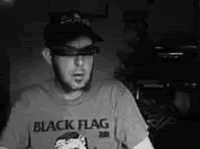So it's been awhile since I've graced you all with a new blog. There are a lot of reasons behind that. I could go into them all, but to have to consider them all and then write about them would be akin to tying an anchor around my neck at this point, and for the first time in a long time, I feel like my head is actually above water.
One reason is that I've been spending most of my "Gheyspace Time" over on Facebook. I finally caved in and started an account, with my real name. Found my high school class and joined their group. I hooked back up with many people I haven't talked to in twenty years. And then I found my college crew. And others. It's strange, I assumed I would never talk any of these people ever again, a lot of them were no more than a faded memory. It's great to see so many people doing well, it makes me wonder what's become of the ones that I haven't reconnected with. I take it all with a grain of salt, though, as several of these people wouldn't have given me the time of day back then. Older and wiser, I am, as are they.
I was very happy, though, to find my best friend from high school. I had abandoned our friendship a few years back, for selfish reasons. It made me so happy to find that she is doing well and is happy and even has a few kids.
----
I've also been doing a lot of soul searching regarding this retirement-thing. When you do something for twenty-some-odd years, when your heart and soul were in it, it's hard to decide to walk away, even when it appears to be the logical choice. When my gear got ripped off, though, it was easy to say "Fuck it, I'm DONE." Two years ago, an incident like that would have made me come back and try twice as hard. Now, though, it just made it easier to sell everything else off. It's all gone- The amps, the mics, the pedals, the PA, all of it. The only thing left is my bass and my magic distortion pedal. Even all of the recording gear is gone.
----
I've also been very busy working on the book. I could have been done by now, but I have been working my ass off on it. I am ensuring that it will be the very best thing I can possibly produce. For fun, to cool off from the 'work' aspect of writing, I have been composing short stories to go into my memoirs. Sort of a Fear-And-Loathing approach with those. The book should be ready for press by late summer, by time I get done with yelling at my editor and the proof-readers to CHANGE MY FUCKING COPY BACK TO THE WAY I WROTE IT.
-----
Then there is this sickness in me, and the poison they give me to fight it. I am sitting in the waiting room.
----
I take it day by day. I even have no idea what state I'll be living in two weeks from now.
Selah.
Wednesday, May 6, 2009
Friday, February 13, 2009
Space Junk
Space crash called "catastrophic," lots of debris
By VLADIMIR ISACHENKOV
story source (AP)
MOSCOW (AP) — The crash of two satellites has generated an estimated tens of thousands of pieces of space junk that could circle Earth and threaten other satellites for the next 10,000 years, space experts said Friday.
One expert called the collision "a catastrophic event" that he hoped would force President Barack Obama's administration to address the long-ignored issue of debris in space.
Russian Mission Control chief Vladimir Solovyov said Tuesday's smashup of a derelict Russian military satellite and a working U.S. Iridium commercial satellite occurred in the busiest part of near-Earth space — some 500 miles (800 kilometers) above Earth.
"800 kilometers is a very popular orbit which is used by Earth-tracking and communications satellites," Solovyov told reporters Friday. "The clouds of debris pose a serious danger to them."
Solovyov said debris from the collision could stay in orbit for up to 10,000 years and even tiny fragments threaten spacecraft because both travel at such a high orbiting speed.
James Oberg, an experienced aerospace engineer who worked on NASA's space shuttle program and is now a space consultant, described the crash over northern Siberia as "catastrophic event." NASA said it was the first-ever high-speed impact between two intact spacecraft — with the Iridium craft weighing 1,235 pounds (560 kilograms) and the Russian craft nearly a ton.
"At physical contact at orbital speeds, a hypersonic shock wave bursts outwards through the structures," Oberg said in e-mailed comments. "It literally shreds the material into confetti and detonates any fuels."
Most fragments are concentrated near the collision course, but Maj.-Gen. Alexander Yakushin, chief of staff of the Russian military's Space Forces, said some debris was thrown into other orbits, ranging from 300 to 800 miles (500-1,300 kilometers) above Earth.
David Wright at the Union of Concerned Scientists' Global Security said the collision had possibly generated tens of thousands of particles larger than 1 centimeter (half an inch), any of which could significantly damage or even destroy a satellite.
Wright, in a posting on the group's Web site, said the two large debris clouds from Tuesday's crash will spread over time, forming a shell around Earth. He likened the debris to "a shotgun blast that threatens other satellites in the region."
Meanwhile, there's no global air traffic control system that tracks the position of all satellites.
The U.S. military tracks some 17,000 pieces of space debris larger than 2 to 4 inches (5 to 10 centimeters), along with some 900 active satellites. But its main job is protecting the international space station and other manned spacecraft, and it lacks the resources to warn all satellite operators of every possible close call.
"With the amount of spacecraft and debris in orbit, the probability of collisions is going up more rapidly," said John Higginbotham, chief executive of Integral Systems Inc., a Lanham, Maryland-based company that runs ground support systems for satellites.
Oberg said the limited accuracy of tracking data and computer calculations makes it impossible to predict collisions, only their probability. He said most satellites also have little fuel to escape what most likely would be a false alarm.
"The collision offers a literally heaven-sent opportunity for the Obama administration to take forceful, visible and long-overdue measures to address a long-ignored issue of 'space debris,'" Oberg said.
In January 2007, China destroyed one of its own defunct satellites with a ballistic missile at an altitude close to that of Tuesday's collision, creating thousands of pieces of debris which threatened other spacecraft.
Both NASA and Russia's Roscosmos agencies said there was little risk to the international space station, which orbits 230 miles (370 kilometers) above Earth, far below the collision point. An unmanned Russian cargo ship docked smoothly Friday at the station, delivering water, food, fuel, oxygen and other supplies as well as a new Russian space suit for space walks.
American astronauts Michael Fincke and Sandra Magnus are aboard the station along with Russian Yuri Lonchakov. The crew size will be doubled to six members later this year.
AP Technology Writer Peter Svensson in New York and AP Science Writer Seth Borenstein in Washington contributed to this report.
Subscribe to:
Posts (Atom)










